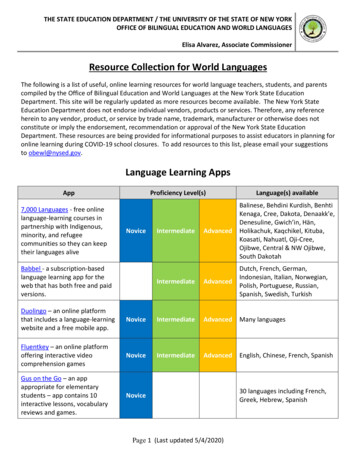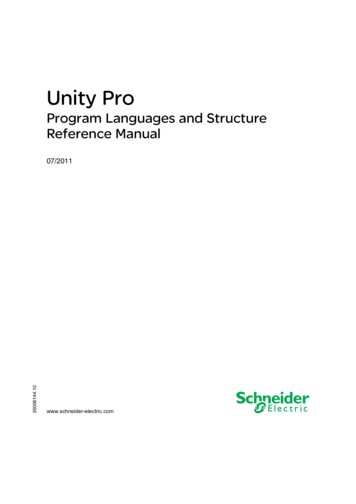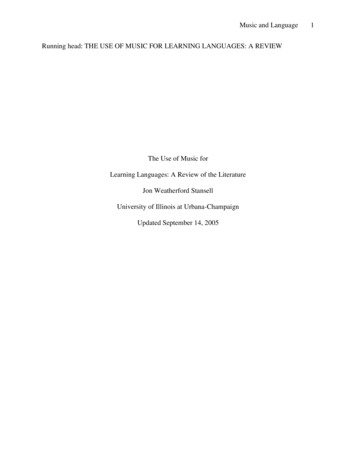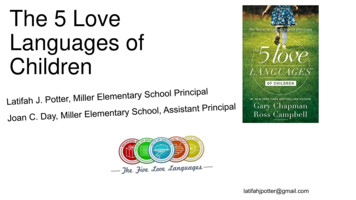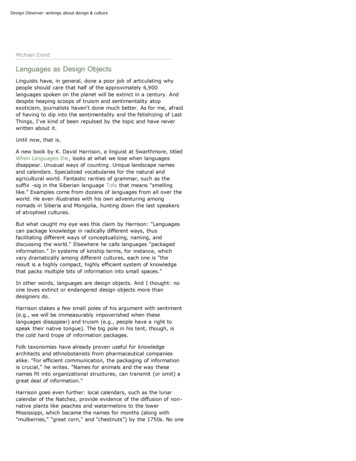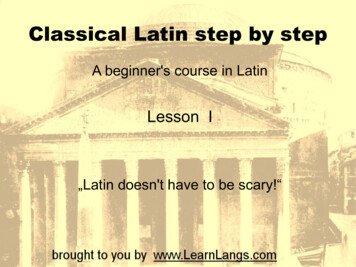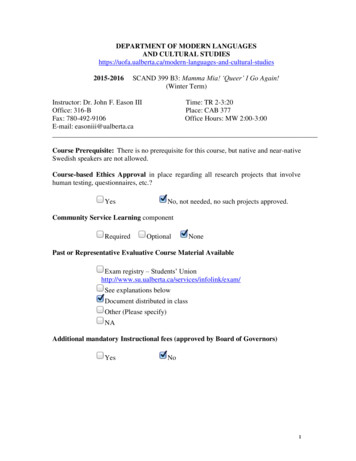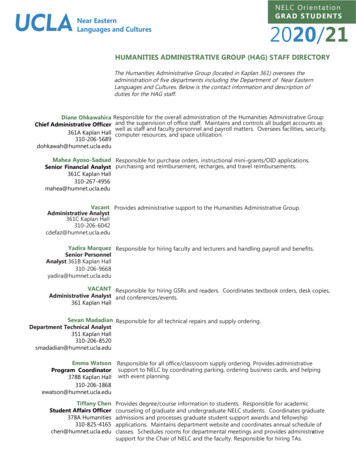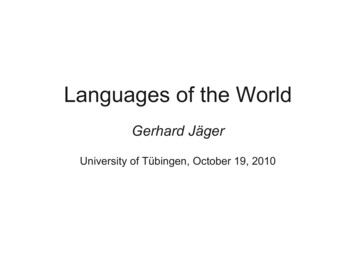
Transcription
Languages of the WorldGerhard JägerUniversity of Tübingen, October 19, 2010
Introduction How many languagesare spoken today?Ethnologue (2005):6 912: table 1Number of speakersvaries substantiallylanguages per continentAfricaAmericasAsiaEuropePazific
How many languages?many languages in Europe
How many languages?ca. 150 languages in Europe, 40 the Caucasus alone
Around 7,000 languages world-widehigh diversity around the equator
(data from 1999 edition of Ethnologue)
liRussianJapaneseGermanWu renchUrduYue (Kantonese)Turkishnumber of native speakers 15551More recent data source
Quantitative distribution
Quantitative distribution Zipfian distributionNumber of speakersis inverselyproportional to rankof a languageFrequent distributionin linguistics/socialsciences
Language diversity in past, present, future10,000 BCE1000 CE1500200020502100220020,000 languages9,000 languages7,500 languages6,500 languages4,500 languages3,000 languages100 languagessource: Martin Haspelmath
What counts as „speaker“? 1996 edition of Ethnologue: 266 million speakerof Spanish 1999 edition: 322 million Does not correspond to population growth Data sources are sometimes unreliable
What counts as a language? Arabic does not belong to „top twenty“–Arabic (including all variants): 202 mill. speaker(would amount to 4th rank)–Ethnologue treats different variants of Arabic asdifferent languages–Justification: variants are mutually unintelligible.Algerian and Egyptian Arabic are as different asSpanish and Portuguese.
What counts as a language? Hindi and Urdu are the same language–History/politics: differernt writing systems, differentstrata of loan words–Regular speakers understand each other fairly well–If counted as one language, Hindi/Urdu would be on4th place.
What counts as a language? Depending on how you count, Turkish mighthave higher number of speakers–51 millionen speakers (46 million in Turkey)–However, more than 80 million people speak alanguage that is mutually intelligible with Turkish–Counting them in would bring Turkish to 10th rank
What counts as a language? Serbo-Croatian–Before Balkan wars of the nineties: –Serbo-Croation counted as one languageTwo writing systems – Latin alphabet in Croatia, kyrillicalphabet in SerbiaContinuum of dialectal variantsNow: Three languages – Serbian, Croation, Bosnian
What counts as a language? Scandinavian–Norwegian and Swedish – and, up to a point, alsoDanish, are mutually intellibible–Count as different languages though, because theyare associated with different countries
What counts as a language? Chinese–Is frequently considered a single language–Consists of at least seven different languages(with considerable internal dialectal variation)–Chinese is considered as a unit for cultural andpolitical reasons, like the common writingsystem
What counts as a language? Chinese
What counts as a language Dialect continua–Portugese, Spanish, French and Italian arecounted as different languages–Nonetheless, local dialects changes onlygradually if you travel from town to town fromPortugal to Italy.–The same holds for German and Dutch.
What counts as a language
What counts as a language Cynically speaking: A language is a dialectwith an army and a navy.Distinction between language and dialectcannot be done by purely linguistic criteriaIn the end, it is a political and cultural decisionof a linguistic community about its identityCriteria from Ethnologue
Language families Languages: no clearly separated unites, rathera hierarchy/tree structure.–Categories can be split into ever smaller units, untilthe level of the single speaker–Assumption of a meta-unit is justified if there isevidence for a common origin
Language families German belongs to the family of Indo-EuropeanSometimes also called (obsolete now) „IndoGermanic“It is the language family that was discoveredfirst and is best studied
The Indo-European language family Ancient times: little interest in comparativelinguistic researchMiddle ages:–Written documents from many European languages–Wide-spread assumption that all languagesoriginate from Hebrew–No real concept of language changeReal starting point of comparative linguisticswas the discovery of Sanskrit
The Indo-European language family William Jones 1786:„The Sanskrit Language, whatever be its antiquity, is ofwonderful structure; more perfect than the Greek, more copiousthan the Latin, and more exquisitely refined than either; yetbearing to both of them a stronger affinity both in the roots ofverbs and the forms of grammar, than could possibly have beenproduced by accident; so strong indeed that no philologer couldexamine them at all without believing them to have sprung fromsome common source, which perhaps no longer exists: there issimilar reason, so not quite so forcible, for supposing that boththe Gothic and the Celtic, though blended with a different idiom,had the same origin with the Sanskrit; and the old Persian mightbe added to the same family, if this were the place fordiscussing any question concerning the antiquities of Persia.“
The Indo-European language family Cœurdoux 1767Sanskrit „widow“Latindeuspes, ped-isGreektheóspoús, podo-ósmégasviduvaAlso grammatical similarity between Greek andSanskritPartially incorrect according to modern insights(for instance, the Greek cognate to lat. deus isZeus, not theos
The Indo-European language familySanskritas-mias-ias-tis-mass-thas-antiLatinI amyou(sg.) arehe iswe areyou(pl) arethey ares-umeses-ts-umuses-tiss-unt
The Indo-European language family Sanskrit as- and lat. es- both mean „to be“ Both have allomorph s- Inflectional paradigm comprises both variants Sanskrit has additional suffix -i; otherwise the suffixesare virtually identicalSufficient evidence to establish genetic relatedness
The Indo-European language family Reconstructed paradigm of the Indo-Europeanproto Vs-Vnt(i)
The Indo-European language family Middle of 19th century: discovery of sound lawsPhonological change is not arbitrary, butapplies essentially to all words of a languageFor instance Grimm's Law (applies to allGermanic languages),High German consonant shift (applies to allHigh-German dialects)
Sound laws and the reconstructionof language families Applicable to other languages as well(example from Austronesian)Reconstruction is usually possible at most until8,000 years into the past
The Indo-European language family Modern Indo-European languages are–All European languages except Hungarian, Finnish,Estonian, and Basque–Many West Asian and South Asian languages
Distribution of IE languages
Family tree of the IE languages
Branches of the IE family
Branches of the IE family 8 living branches 2 well-documentedextings ndo-Iranian–Armenian several poorlydocumented extinctbranches
Branches of the IE family Indo-Iranian–Indo-Aryan: Sanskrit,Marathi, Sinhala, Hindi,Urdu,Bengali,–Iranian: Avestan, ancient Persian (cuneiformdocuments), Farsi, Pashto, Kurdish, Balochi, .–Nuristani: Kati, Prasuni, Ashkunu, Waigali,Gambiri, (small languages, mostly spoken inPakistan/Afghanistan)
Branches of the IE family Armenian:–Old Armenian, Eastern Armenian, WesternArmenian
Branches of the IE family Balto-Slavic:–Slavic: East Slavic: Russian, Belarussian, Ukrainian, RuthenianWest Slavic: Sorbian (Upper Sorbian, Lower Sorbian),Polabian (extinct), Polish, Pomeranian (Kashubian,Slovincian (extinct)), Czech, SlovakSouth Slavic: Burgenland Croatian, Bosnian, Croatian,Molise Croatian, Macedonian, Montenegrin, Serbian,Slovenian
Branches of the IE family Balto-Slavic:–Baltic: Eastern Baltic: Lithuanian, Latvian, Curonian, Selonian(extinct), Semigallian (extinct)Western Baltic (extinct): Old Prussian, Sudovian,Galindian, Skalvian
Branches of the IE family Celtic:–Continental Celtic (extinct): Gaulish, Galatian,Lepontian, Celtiberian–Insular Celtic: British languages: Cumbric (extinct), Welsh, Cornish(extinct), BretonGoidelic languages: Irish, Scottish Gaelic, Manx
Branches of the IE family Germanic:–East Germanic (extinct): Burgundian, Vandalic,Gothic–North Germanic: Norwegian, Faroese, Jamtlandic,Norn (extinct), Swedish, Danish, Gutnish–West Germanic: English, Scots, Frisian, Dutch,Low German, German, Swiss German, Yiddish, .
Branches of the IE family Romance (Italic):–Latino-Faliscan: Latin (extinct), Faliscan (extinct),Spanish, Portuguese, French, Italian, Romanian,Moldovan, Catalan, Galician, Occitan, Sardinian,Ladin, Romansh–Osco-Umbrian (extinct)
Branches of the IE family Greek Albanian Illyric (extinct) Venetic (extinct) Lusitanian (extinct)
Branches of the IE family Tocharian (extinct):–Was spoken in second half of the first millenium inpresent day China–About 5,000 written documents survive
Branches of the IE family Anatolian languages (extinct):–Hittite, Lydian, Palaic, Luwian, Lycian, Carian,Pisidian, Sidetic Phrygian (extinct) Thracian (extinct) Macedonian (extinct; was spoken duringantiquity, unrelated to modern Macedonian,which is a Slavic language)
Language families Language family: group of genetically (i.e.historically) related languagesDescent from a common proto-languageDescent has to be established via generallyaccepted methodsClassification is (unavoidably) variable andsometimes subjectiveEthnologue counts more then 100 languagefamilies
Language families
Language families
Language families Afro-Asiatic–Also called „Hamito-Semitic“ (obsolete)–subgroups: Semitic (Arabic, Hebrew, Amharic, .)Berber (Tuareg, .)Egyptian (extinct)Cushitic (Somali, Oromo, .)Chadic (Hausa, .)
Language families Nilo-Saharan–Comprises about 200African languages–Nubian, Fur, .
Language families Niger-Congo languages–Most importantsubgroup: Bantulanguages–Swahili, Rwanda,Zulu, Yoruba
Language families Khoisan languages–Languages of thebushmen in SouthernAfrica–Use click sounds(which aretypologicallyuncommon)
Language families Uralic–subgroups Finno-ugric: Hungarian, Estonian, Sami, KarelianSamoyedic ( 30,000 speaker in Nothern Eurasia)
Language families Altaic–subgroups –Turkic: Turkish, Turkmen, Kyrgyz, KazakhMongolicTungusic (Northern China, East Siberia)KoreanJapanesePartially controversial, especially the inclusion ofKorean and Japanese
Language families Dravidian–Telugu, Tamil, Kannada, .–Spoken mainly in Southern India and Sri Lanka
Language families Sino-Tibetan–subgroupsSinitic (chinese languages) Tibeto-Burman (spoken in Myanmar, NorthernThailand, Nepal, Bhutan, parts of China, Indiaand Pakistan): Tibetan, Brahmaputran, .
Language families Austro-Asiatic–Vietnamese, Khmer, Santali–Spoken in South-East Asia and Northern India
Language families Austronesian–Family with the largest geographical expansion(from Madagaskar in the West until Hawaii in theEast)–Malagasy, Javanese, Bahasa Indonesian, Tagalog,Taiwanese languages, Maori (language of theaborigines of New Zealand), polynesianlanguages, .
Language families Tai-Kadai languages–Thai, Isan, Lao, .–Speculations, that Austronesian and Tai-Kadai forma single family („Austro-Thai“)
Paleo-American language families Classification according to Greenberg:–Eskimo-Aleut–Na-Dene (Northern and Western North-America)–Amerindian (rest of North-America and SouthAmerica)„Amerindian“ is heavily contestedUsing traditional methods, only many muchsmaller families can be established
Language families In many cases, it is impossible to come up witha clear classification–700 languages in Papua-New Guinea, oftenunrelated to each other–Several hundred languages of Australianaborigines; genetic classification is unclear–Many „isolated“ language (i.e. no geneticrelationship to any other language can beestablished), for instance Basque
Language familiesNumber of languages per family also follow Zipfian distribution
Danish, are mutually intellibible . verbs and the forms of grammar, than could possibly have been produced by accident; so strong indeed that no philologer could examine them at all without believing them to have sprung from some common source, which perhaps no longer exists: there is similar reason, so not quite so forcible, for supposing that both the Gothic and the Celtic, though blended .

